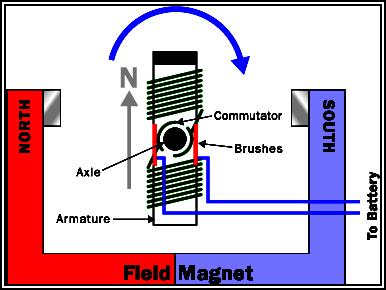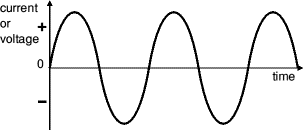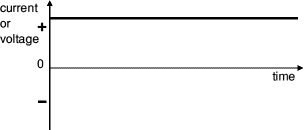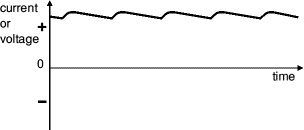Electric motor
Introduction to electric motors
An electric motor is all about magnets and magnetism. An electric motor uses magnets to create motion. You know the law of magnets: opposite poles attract and like poles repel. So if you have two bar magnets with their ends marked "north" and "south," then the north end of one magnet will attract the south end of the other. On the other hand, the north end of one magnet will repel the north end of the other. Inside an electric motor, these attracting and repelling forces create rotational motion.

What is an electric motor?
An electric motor is an electromechanical device that converts electrical energy to mechanical energy. This mechanical energy is used, for example, to rotate a pump impeller, fan or blower, drive a compressor, lift materials etc. Electric motors are sometimes called the “work horses” of industry; it is estimated that motors use about 70% of the total electrical load in industry.
Components of electric motors
If you take apart a small electric motor, you will find that it contains the following: two small permanent magnets inside casing, two brushes held in housing, and an electromagnet that is made by winding wire around pieces of shaped metal (laminations) on a steel shaft, known as an armature or rotor. The rotor will almost always have three poles or more, and there are two good reasons this:
1. Having three or more poles causes the motor to have better dynamics (movement). In a two-pole motor, if the electromagnet is at the balance point, which is perfectly horizontal between the two poles of the field magnet when the motor starts, you can imagine the armature getting "stuck" there. That never happens in a three-pole motor, which can start turning from any starting position.
2. Each time the commutator hits the point where it flips the field in a two-pole motor, the commutator temporarily shorts out the battery (i.e., it directly connects the positive and negative terminals). This shorting wastes energy and needlessly drains the battery. A three-pole motor solves this problem. In fact, an efficient motor’s timing switches on the armature when the magnetic repulsion is strongest.
An electric motor can have any number of poles, depending on the size of the motor and its specific application. Motors come in different shapes and sizes to fit almost anywhere.
Types of Electric Motors

How does an electric motor work?
The general working mechanism is the same for all electric motors (see first figure above):
a) An electric current in a magnetic field will experience a force.
b) If the wire that carries current is bent into a loop, then the two sides of the loop, which are at right angle to the magnetic field, will be forced in opposite directions.
c) The pair of forces creates a turning torque to rotate the coil.
d) Practical motors have several loops on an armature to provide a more uniform torque. The magnetic field is produced by electromagnet arrangement called the field coils.
.
Want to know more about electric motors? Click here to schedule a live session with an eAge eTutor!
About eAge Tutoring:
eAgeTutor.com is the premium online tutoring provider. Using materials developed by highly qualified educators and leading content developers, a team of top-notch software experts, and a group of passionate educators, eAgeTutor works to ensure the success and satisfaction of all of its students.
Contact us today to learn more about our guaranteed results and discuss how we can help make the dreams of the student in your life come true!
Reference links:
AC and DC current
Introduction to AC and DC Current
 AC means “Alternating Current” and DC means “Direct Current.” AC and DC are also used when referring to voltages and electrical signals, which are not currents. DC is electricity flowing in a constant direction, and/or possessing a voltage with constant polarity.
AC means “Alternating Current” and DC means “Direct Current.” AC and DC are also used when referring to voltages and electrical signals, which are not currents. DC is electricity flowing in a constant direction, and/or possessing a voltage with constant polarity.
DC is the kind of electricity that a battery with definite positive and negative terminals makes, or the kind of charge that is generated by rubbing certain types of materials against each other. Certain sources of electricity (most notably, rotary electro-mechanical generators) naturally produce voltages that alternate in polarity, reversing positive and negative over time. Either as a voltage switching polarity or as a current switching direction back and forth, this "kind" of electricity is known as Alternating Current (AC).
What is Alternating Current (AC)
 Alternating Current (AC) flows one way, then the other way, continually reversing direction. An AC voltage is continually changing between positive (+) and negative (-). The rate of changing direction is called the frequency of the AC and it is measured in hertz (Hz), which is the number of forwards-backwards cycles per second. An AC supply is suitable for powering some devices such as lamps and heaters but almost all electronic circuits require a steady DC supply.
Alternating Current (AC) flows one way, then the other way, continually reversing direction. An AC voltage is continually changing between positive (+) and negative (-). The rate of changing direction is called the frequency of the AC and it is measured in hertz (Hz), which is the number of forwards-backwards cycles per second. An AC supply is suitable for powering some devices such as lamps and heaters but almost all electronic circuits require a steady DC supply.
This shape portraying AC from a power supply is called a sine wave. Alternating current is the most common form used in the transmission of electricity from power plants to homes and businesses. It is convenient because the voltage can be changed easily with transformers. High voltage is good for long-distance transmission of electricity because it means less current has to flow to achieve the same amount of power, and power is lost in the resistance of wires in proportion to the square of the current. Alternating current is generated at the power station by rotating a coil of wire inside a big magnet. The energy needed to make the coil turn is provided by burning fuels such as coal, oil, natural gas, or by harnessing air, water, or nuclear power to do it. Faraday's law of induction relates the change in the voltage around the coil of wire to the rate of change of the amount of magnetic flux through the wire. If the wire turns around in circles, the voltage will be positive, then negative, then postitive again. Because the voltage swings back and forth between positive and negative values, at some times it crosses zero.
What is Direct Current (DC)
Direct Current (DC) always flows in the same direction, but it may increase and decrease. DC voltage is always positive (or always negative), but may increase and decrease. Electronic circuits normally require a steady DC supply which is constant at one value or a smooth DC supply which has a small variation called ripple.
Cells, batteries, and regulated power supplies provide steady DC which is ideal for electronic circuits.
Power supplies contain a transformer which converts the mains AC supply to a safe low voltage AC. The AC is then converted to DC by a bridge rectifier. However, the output is varying DC which is unsuitable for electronic circuits.
Direct current is very useful in powering small things such as flashlights and radios and toys. Batteries are the most common source of direct current -- the voltage of a battery is constant. Things that need lots of power in the form of direct current, like computers, have power supplies inside which transform alternating current from the wall plug to direct current. This way, they don’t run out of batteries.
Steady DC
from a battery or regulated power supply, this is ideal for electronic circuits.
Smooth DC
from a smoothed power supply, this is suitable for some electronics

Want to know more about AC and DC current? Click here to schedule a live session with an eAge eTutor!
About eAge Tutoring:
eAgeTutor.com is the premium online tutoring provider. Using materials developed by highly qualified educators and leading content developers, a team of top-notch software experts, and a group of passionate educators, eAgeTutor works to ensure the success and satisfaction of all of its students.
Contact us today to learn more about our guaranteed results and discuss how we can help make the dreams of the student in your life come true!
Reference links:
- http://www.science.howstuffworks.com › ... › Physical Science › Electricity
- http://www.allaboutcircuits.com › ... › BASIC AC THEORY
- http://www.hyperphysics.phy-astr.gsu.edu/hbase/electric/elevol.html




